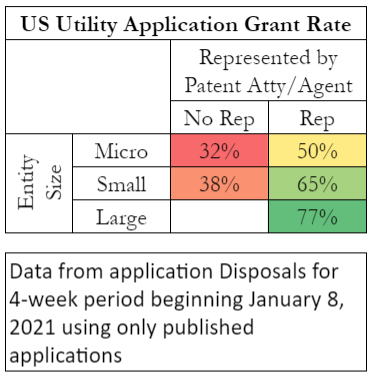Should you try to file a patent yourself?
Should you file a utility patent application yourself? Would your utility patent application enjoy a higher success rate if it were filed by a patent attorney? This recent study by Dennis Crouch provides some data to show that using a patent attorney does, in fact, increase your probability of sucess compared to filing a do-it-yourself utility patent application.
Need to get a patent? Email Vic at vlin@icaplaw.com or call (949) 223-9623 to request flat rate estimates.
Do-It-Yourself (DIY) a wise option?
Keep in mind we’re talking about utility patents as opposed to design patents. Generally, design patent applications are much simpler since there is not much writing involved. You need to make sure the design patent drawings are illustrated properly pursuant to the strict USPTO design drawing rules.
Writing a utility nonprovisional patent application, however, is another story. Not only do the figures and descriptions need to be sufficiently fleshed out, but the claims have to be properly drafted. A good deal of judgment is involved in determining the sweet spot for the scope of the independent claims. Too narrow, and the claims will get allowed without sufficient breadth. On the other hand, broadly worded claims will get rejected, but will also have the opportunity for further amendments to find the right scope.
Experienced practitioners may typically aim for a broader scope, recognizing that claims will get rejected in the vast majority of cases. We wait and see what prior art the examiner can find, and then proceed accordingly.
What are the differences in percentages of approval of patent applications?
As shown below, this helpful chart by PatentlyO.com provides a helpful comparison of percentage success rates between do-it-yourself applicants and professionals:

For micro entity applicants, the percentage of success increases from 32% for self-filers to 50% when using a professional. This 18 point bump represents a 56% greater chance of success when filing through a patent attorney.
For small entity applicants, the probability of sucess increases from 38% without representation to 65%. with representation. This 27 point increase represents a 71% greater chance of success over do-it-yourself applicants.
Notice how large entity applicants have no grants without representation. That fact alone would suggest that large entity applicants file patents only with representation.
Would higher legal costs justify higher percentages of success?
The assumption beneath the data is that applicants with representation spent more money than self-filers. The chart above does not show the success rates of Office Action responses or what proportion of each group even bothered to file a response. At a minimum, the grant percentages do show that the majority of do-it-yourself patent applicants fail to overcome the rejections of their applications. Small entities have a slight edge over micro entities, but even a 38% chance of success is still abysmal.
So we now know that applications with representation leads to greater success than those without. OK, but how do you pick representation
How do you pick a better patent attorney?
Of course, the data does not distinguish between practitioners. I wrote an article here on how to choose a patent attorney. When it comes to utility nonprovisional applications, major on the majors.
You want a detailed description with figures that adequately show the unique features of your invention. Your independent claims should strike a reasonable balance between a broader scope and sufficient novelty to get past the prior art. If your team includes a former USPTO examiner, you will gain an advantage in accomplishing more effective examiner interviews that will hopefully lead to an allowance with fewer rejections.
Want to explore whether we’re a good fit for you? Contact US patent attorney Vic Lin at vlin@icaplaw.com or call (949) 223-9623 to see how we can help you get your patents granted.


